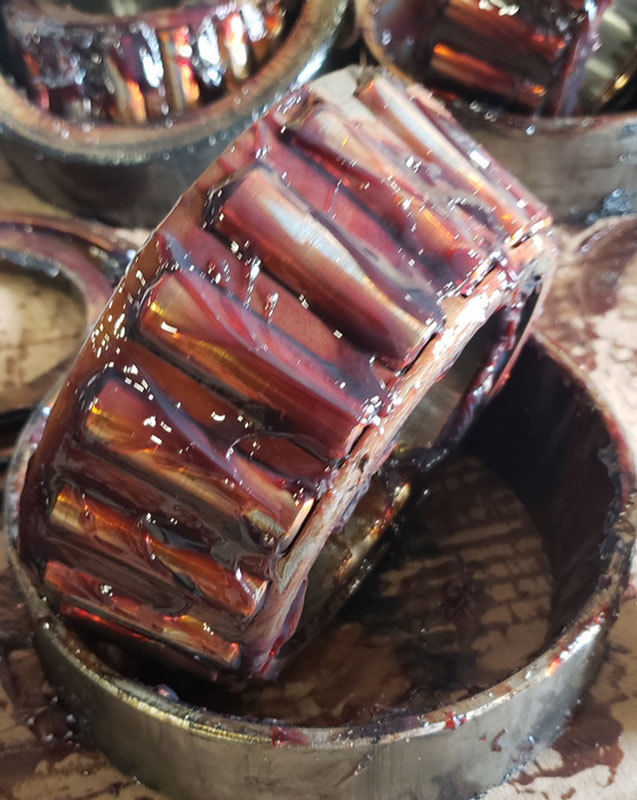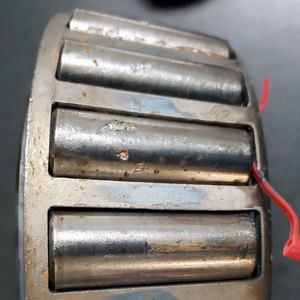Putting the Right Grease to Work for Your Mill







PHOTos: Schaeffer Oil
August 19, 2021
BY Karen Wright and Matt Meyer
Contaminants such as dirt, dust particles and moisture make it difficult to keep bearings properly lubricated in pellet mills. Dust particles and debris in the material being pelletized can mix with the grease, causing sticky buildup and restricting grease flow. Water and steam used in the production process can also affect grease performance.
Bearings in pellet mills aren’t typical applications where the grease stays in one place and is reapplied at set intervals. Rather, grease used in pellet mills is often applied in a constant flow by an auto-lube system to keep relubricating and help cool the system.
Dust and debris are constant threats to the grease and bearings. Once those particles make their way to the grease in a hot environment, the wood debris can stick to the rolling elements, harden and cause wear. Using high-quality grease with proper greasing intervals can help combat the effect of debris on the bearings, gears and races.
Finding the right grease is crucial when you consider how much grease is consumed by a pellet mill. Too much is affected by grease to simply go with just any grease—the weight of the loads, the service life of components and profit margins. It’s a matter of choosing performance over price, but how do you know the grease will function properly in your mill? The answer will vary by mill, based on what factors are monitored and measured. For example, a pellet mill processing southern wood may monitor regreasing intervals to indicate grease performance. A high-quality grease may allow for a reduction in grease application, which benefits the bottom line. Another pellet mill processing harder wood may base success on the hours on the bearings and how often it’s able to reuse them. The right grease may allow for double or triple hours on bearings, which can represent tremendous savings.
Factors to Consider
To find the right grease for your mill, begin with the materials being pelletized. Is it hardwood or softwood? Knowing the material type determines the load that’s going to be carried by the bearings. The goal is to have proper film strength from the grease to keep metal surfaces apart. Grease releases its oil when it’s subjected to pressure and heat; the oil is what protects the surfaces from debris, heat and steam.
Hardwoods such as oak, cherry and hickory need a grease with a base oil of ISO 680 because the machine uses more force to push the material through for pelletizing. Softwoods like southern yellow pine do better with a grease that has a base oil of 460, which allows the machine to work efficiently and within temperature range.
Not only does the base oil viscosity enable the grease to handle the load, but it also helps keep operating temperatures in check. Base oil gives the grease its cooling ability. It’s better to use the right viscosity for the application instead of over-greasing the bearings.
When grease isn’t meeting the demands of the work, you’ll see signs of bearing wear and missing metal, and equipment will experience temperature spikes. Not only does this sound the alarms or cause shutdowns, but it can also put the mill at risk for a smoldering event. Sometimes, when temperatures spike, it may not mean more grease is needed. Instead, it could be that the process materials themselves cause the temperature increase. Even when the same material type is being processed, variances in the wood may be present, which can cause the machine to work harder to push the material through. In pellet mills, it’s a delicate balance between proper grease intervals and using a grease that withstands the temperatures.
Steam percentage is another factor to consider when selecting the right grease. Heat and steam accelerate the aging process of grease. Any time the grease is heated, it will begin to bleed and release its oil, which is how it lubricates. In pellet mills, wood debris creates a unique problem because wood is absorbent, so it will absorb the beneficial oil. This shortens grease life, as the oil contains all the performance additives. Whenever wood dust absorbs the oil, it becomes sticky and acts as a plug around the seals to inhibit proper grease flow.
The presence of wood debris can’t be avoided, but operators can choose a grease that behaves better when exposed to moisture. The technical data sheet should be checked for the grease’s ratings for copper corrosion, as well as water washout and spray off. High ratings and percentages indicate the grease doesn’t stand up as well to water. In terms of grease thickeners, aluminum complex and lithium complex have better resistance to water while providing the temperature protection needed for pellet mills.
In pellet mills, it’s almost a continuous flow of new grease in and out of the bearings. Because of the need for frequent reapplication, auto-lubricators and a centralized grease system are often used. Grease pumpability comes into play, because the grease may be in one part of the plant while the application is further away. In some instances, grease is flowing through 100 feet of grease lines. It must be able to flow properly without needing excessive pressure, which can trigger the grease to bleed. Base oil viscosity, plus using the right NLGI grade, usually #2, contribute to the grease’s pumpabilty.
Using the right grease for your mill can extend preventative maintenance intervals, increase bearing life and increase the volume of pellets produced between bearing and ring changeouts. When choosing a grease, remember to pay attention to what the OEM recommends based on the materials your mill is pelletizing. Identify the normal temperature ranges for the equipment and what the loads are, and determine what kind of performance you expect from the equipment. This information, plus a good maintenance schedule, will help ensure the grease you use is performing as it should for your mill.
Schaeffer Manufacturing Co. is a sixth-generation, family-owned company that sells its products to upward of 40 countries. Its 228HV grease is known to significantly improve one of operating pellet mills’ most problematic occurrences when it comes to equipment—bearing failures.
Author: Karen Wright and Matt Meyer
Schaeffer’s Specialized Lubricants
www.schaefferoil.com
314-865-4100
Advertisement
Advertisement
Advertisement
Advertisement
Upcoming Events





